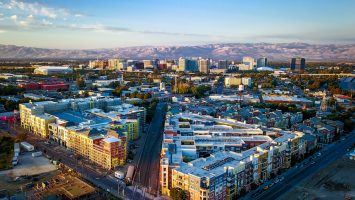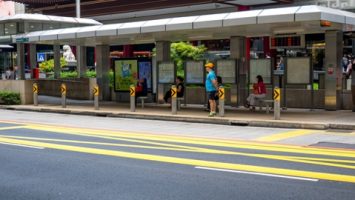
Melanie Morgan isn’t just a Data Analyst for the City of Centennial, Colorado, one of the most forward-thinking city-based innovation teams in the country; she also has a background in city planning and public health.
“I’m interested in how the shape of our cities influences the health and happiness of the people who live there,” she said. “This position on the [Innovation Team] i-Team allows me to work inter-departmentally in a way that is untraditional for these fields.”
We spoke with Melanie about the Innovation Team (i-Team), current projects, and the future of smart in her region.
SCC: The Innovation Team for the City of Centennial has taken on a number of projects over the past few years. Tell me about that group and how it functions within the city.
MM: The team was initiated by a grant from Bloomberg Philanthropies in 2015. The intention behind the grant was to provide seed funding for small, nimble research, and prototyping teams that could address some of the biggest challenges facing American cities. Centennial was the only suburb to receive a grant through this program; and, as evidenced by the City Council’s decision to continue funding the i-Team after the conclusion of the Bloomberg Philanthropies grant, this type of thinking is sorely needed in government agencies.
Our team sits within the Office of Strategic Initiatives, which affords the i-Team the opportunity to learn about and integrate diverse projects from across many of Centennial’s departments and contracted partners. My teammates are trained in human-centered design and engineering, skill sets quite different from my own, which allows us to tackle projects from multiple angles. Other skill sets that have been integral to our success as a team are communication, project management, public administration, and institutional knowledge about Centennial’s processes and procedures.
Throughout the team’s tenure, we have focused on two major areas of research: mobility and aging in community.
Within mobility, our research uncovered three major frustrations:
- Residents didn’t know what services existed,
- Travelers couldn’t get to the light rail station, and
- Drivers face automobile congestion.
To address the first, we launched the Mobility Ambassador Program, where the City’s Senior Commission teaches other older adults how to use Lyft, Uber, and the RTD light rail system. To address the second, we partnered with many organizations to test the Go Centennial pilot program. To address the third, we are investigating the benefit of the Internet of Things and various sensor technologies for improving congestion.
During research on aging in community, Centennial residents and professionals serving seniors identified housing as a major area for improvement in the city. We understand that Centennial’s housing stock was not designed with attention to accessibility – in fact, the majority of our homes are multi-story. Rather than wait years until more accessible housing stock has been built, the i-Team is working with other city departments to identify short-term steps to educate residents about low-cost renovations that make their homes more suitable for residents and visitors of all ages and to identify ways the City might incentivize residents and builders to incorporate the most impactful universal design and smart home technologies.
SCC: Centennial is a town not far from Denver. Can you tell me what it’s like to work in a smaller community with such close proximity to a huge urban area?
MM: Centennial is a very unique city. We are the 10th largest city in Colorado with a population over 109,000. We are also a relatively new city, incorporated in 2001; and the bulk of our services are contracted to private providers who offer superior quality and lower costs for our residents. This small staff and lack of institutional bureaucracy provides a level of flexibility and agility not typical of government. With fewer staff and fewer inter-related services, and with strong processes for partnering and contracting with the private sector, we are able to move rapidly from pilot idea to implementation.
At the same time, our location within the Denver region is a major benefit for Centennial. Our businesses have access to more highly educated and specialized employee talent than a typical city of our size. We attract employees from the rest of the metro area – approximately 56,000 employees travel into Centennial to work, and approximately 46,000 Centennial residents work outside the city. In my experience, the members of the Denver metro area operate much more regionally than other major metros, approaching economic development, transit, and roadway planning with a collaborative mindset.
SCC: Centennial has its own set of challenges and goals, independent of its neighbors. What are some of those, and how has the city begun to solve them?
MM: As a whole, Centennial is facing challenges that are pretty typical for suburban cities. I touched a bit earlier on the specific transportation and aging in community challenges the i-Team is addressing. Single land use zoning – where housing is separated from commercial and office uses – results in long distances between our homes and the destinations we want to reach. As a result, walking is challenging; so people drive even for short trips, resulting in high traffic congestion. We are also not exempt from the challenges that are facing other cities in the Denver metro as a result of economic success – job growth is outpacing housing growth, resulting in high housing costs.
One challenge that is relatively unique to Centennial, given the way it was created from a collection of distinct neighborhoods, is a need to foster and communicate a cohesive community identify and sense of place.
For all of our projects, we look for solutions that are transferable or translatable to other cities across the country. Identifying how our challenges are similar to those of other suburbs helps us do this.
SCC: When you think of a smart city, especially through the lens of the i-Team, what does it mean to you for Centennial to become one? What will it take?
MM: I think a smart city is one that has thoughtful investment. It invests in the right things, at the right time, and is able to say “no” to products and services that don’t measure up. Investing in the right things requires talking to our residents and businesses. We need to hear the diverse needs of our 14 mile-wide city. We need to keep pace as new residents move in, while staying true to the values that formed Centennial a short time ago.
Investing at the right time means coordinating Centennial’s services with those of our partner organizations to ensure, for example, a water district doesn’t cut open a road that was recently repaved by the city’s public works contractor. It also means being able to look ahead and identify which technologies will be essential to the future of our city, like fiber, and which will quickly become obsolete or lock us into inflexible arrangements. Being able to say “no” requires that we have clear goals and processes in place to track quantitative and qualitative progress toward those goals.
I think increasingly in Centennial, and in other cities, we will see a growing awareness of the benefits of prototyping. This is the concept of investing a little money to collect feedback before we make final decisions about spending a lot of money. Prototyping requires everyone to agree that we won’t get it right the first time – every service the city offers can get better, because of each citizen who interacts with it. I predict Centennial, and other cities will get better at adopting processes that allow them to test, improve, test, improve, etc.
SCC: Which steps has Centennial taken toward smart growth and in what ways is the community a leader among its peers?
MM: One example of our effort to develop a smart city is through the construction of a fiber optic backbone, which has been underway since 2016 when the Centennial City Council approved the $5.7 million Fiber Master Plan. The Plan demonstrates the potential benefits that a neutral, carrier-grade fiber backbone can provide to the city and its stakeholder agencies. The city completed construction of its 20-mile central ring of fiber, with construction on the west and east rings of fiber currently underway. The entire 50-mile, 432 strand, city-owned fiber backbone will be completed by end of this year. This fiber network is already proving valuable to Centennial businesses and institutions; the city has signed usage agreements with one of our school districts, a private Centennial-based business, and a private provider that just connected their first resident.
We are also in the process of completing our comprehensive plan. Over the course of this two-year planning process, we spoke with thousands of Centennial residents to hear what was working and what they hoped they could help improve.
SCC: If you could wave a magic wand and receive the perfect solution or technology to solve Centennial’s most pressing challenge, what would you wish for? Why?
MM: Most of the problems our cities face today are “wicked problems” where addressing one cause or symptom has unintended consequences on another part of the system. The problems we face are all related and intrinsically linked to those of our regional neighbors. Because the solutions we are looking for are “better/worse” and not “right/wrong,” I think it is important to think of our solution as a process, rather than as an end state. Installing the newest transportation gadgets might improve our traffic flow next month, but it won’t ensure our roads are ready for whatever level of autonomous vehicles are on the roads in five years.
If I had a magic wand though, I would use it to enable perfect two-way communication between the city and our citizens. The solutions to these wicked problems must be defined collectively, with diverse and frequent input. Historically, cities haven’t asked for public input until late in the process, when many decisions have already been made. That’s starting to change in Centennial with the work of our Customer Experience Manager, but it is still a fine line — residents are busy and have many priorities competing for their time — news about changes across town isn’t always welcome. I’d love to develop a system where residents have exactly the information they want and none of the information they don’t want.
SCC: Smart Cities Connect Conference and Expo will land in Denver next April for four days of workshops, panels, keynotes, and networking. What do you hope attendees will discover, not only about Denver, but about the broader community? What do you hope to get out of the event yourself?
MM: I think the way forward is to start small, test our hypotheses, and improve with input from our citizens. Centennial is a (relatively) small city with a small staff. I’m looking forward to the Smart Cities Connect Conference as a way to learn from other cities what pilots and technologies have worked, and more importantly, why other projects didn’t, so we can avoid those same pitfalls.
I hope attendees to the conference will take an extra day to stray outside of downtown and enjoy the beautiful weather and natural environments Colorado is known for, whether that means learning the Colorado craft beer craze exists in the suburbs, taking the University of Colorado A-line train from DEN Airport to get a look at the world-class transit system that’s possible when we work regionally, or traveling west for a hike in the mountains.
See you in the Colorado sunshine!


